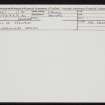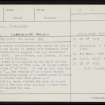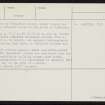Hall Of Ireland, The Cairns
Fort (Prehistoric)(Possible)
Site Name Hall Of Ireland, The Cairns
Classification Fort (Prehistoric)(Possible)
Alternative Name(s) Bay Of Ireland
Canmore ID 1481
Site Number HY20NE 1
NGR HY 2905 0987
Datum OSGB36 - NGR
Permalink http://canmore.org.uk/site/1481
- Council Orkney Islands
- Parish Stenness
- Former Region Orkney Islands Area
- Former District Orkney
- Former County Orkney
HY20NE 1 2905 0987.
(Centred: HY 2905 0987) The Cairns {NR}
OS 6" map, Shetland, 2nd ed., (1903).
'The Cairns', an uneven uncultivated area about 100 yds by 50 yds, close to the shore, is strewn with numerous stony hillocks, too indefinite to suggest that any structures lie beneath the turf. The northern, and largest, is about 25 ft in diameter and 3 ft high.
The name seems to be applied on the OS. 6" of 1882 to a mound at the east end of this area, of larger extent than is shown on the 6" of 1903. It may be this that the Ordnance Survey Name Book (ONB) describes as '...the remains of an ancient Danish fort or castle consisting mainly of a raised mound of earth and loose stones covered over with grass ..'.
The RCAHMS records that a few bone pins are said to have been found in the part nearest the sea.
RCAHMS 1946, visited August 1928.
Name Book 1880
Field Visit (1998)
This extensive site, previously described as being a collection of ill-defined hillocks, may in fact be the remains of a small fort. It was once thought to be the site of a Danish fort. The site and the land which immediately surrounds it has not been cultivated and is very overgrown. While this impedes an examination of the remains, these are sufficiently substantial to be described as an artificial mound or platform with adjoining enclosure. The platform stands up to 3m high, measures 54m by 30m, and is aligned north-south, parallel to the coast. The top of the platform is relatively level but rises slightly to the periphery, possibly indicating the presence of a surrounding bank. Some stone is visible in the sloping sides, suggesting there may have been a revetment wall. A smaller mound lies to the south east side of the platform and may indicate the presence of buried remains here. To the seaward side of the platform a curvilinear bank encloses an area of at least 50m by 10m. The banks are earthen and although somewhat reduced by cultivation and coastal erosion, have the appearances of defences. Bone pins are said to have been recovered from this area. The site has a direct line of view to Stromness and beyond through Hoy Sound.
In all, this site, with its tradition of being a Danish fort, the substantial and defensive nature of the remains and the strategic location strongly suggests that this is a fortification of early historic or medieval date. In view of the fact that such a site would be unusual in an Orcadian context and that it is already subject to coastal erosion, it is recommended that assessment should be carried out as a matter of the highest priority.
Moore and Wilson, 1998
Orkney Coastal Zone Assessment
Field Visit (10 May 2015)
ShoreUPDATE
No archaeological deposits are visible in the coastal section, the visible deposits comprise turf and topsoil over till and bedrock. The earthworks in the hinterland are visible, and the cut of the ditch can be seen in the coast edge where there has been extensive dumping, presumably as an ad hoc coastal defence. This site is in a relatively sheltered and low energy location.
Visited by Scotland's Coastal Heritage at Risk (SCHARP) 10 May 2015
Orkney Smr Note
Some ascribe it to a German of the name of John Ireland after
whom the district of Ireland was named. He having arrived in the
country some time about the 14th century and erected the residence
here, but no definite information regarding it can be gleaned.
Information from Orkney SMR [n.d]












